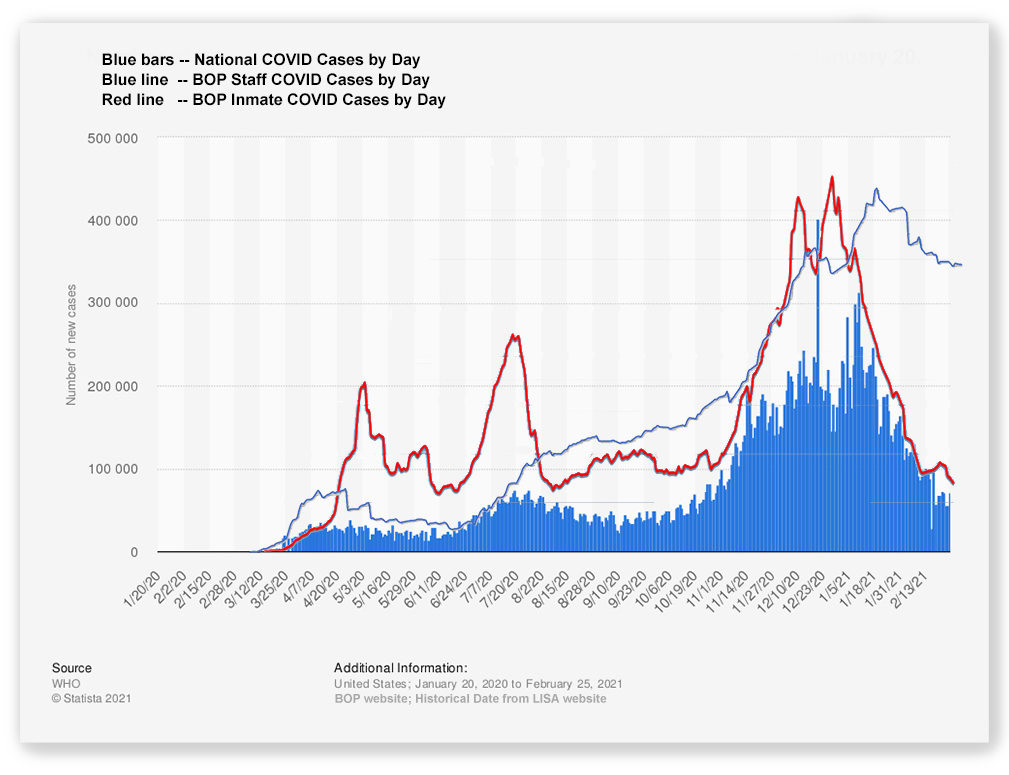We post news and comment on federal criminal justice issues, focused primarily on trial and post-conviction matters, legislative initiatives, and sentencing issues.

COVID AND CARES ACT HOME CONFINEMENT TO GO ON… FOR NOW
 CARES Act Re-upped, As If the BOP Cares: The CARES Act, passed in March 2020, dumped truckloads of money on the coronavirus pandemic. More important that piles of dough (for our purposes, at least), Section 12003 authorized the Federal Bureau of Prisons to place inmates in home confinement as long as the nation is under a COVID emergency and the Attorney General has determined that the “emergency conditions will materially affect the functioning of the Bureau.” President Trump declared a COVID emergency under the National Emergencies Act a few weeks before CARES passed, and Attorney General William Barr made the materiality finding on April 4th.
CARES Act Re-upped, As If the BOP Cares: The CARES Act, passed in March 2020, dumped truckloads of money on the coronavirus pandemic. More important that piles of dough (for our purposes, at least), Section 12003 authorized the Federal Bureau of Prisons to place inmates in home confinement as long as the nation is under a COVID emergency and the Attorney General has determined that the “emergency conditions will materially affect the functioning of the Bureau.” President Trump declared a COVID emergency under the National Emergencies Act a few weeks before CARES passed, and Attorney General William Barr made the materiality finding on April 4th.
Under the National Emergencies Act, an emergency only lasts a year unless the President extends it. That means the emergency would have ceased today, and with it, the CARES Act authority would expire.
Last week, President Biden extended the COVID emergency without specifying an end date (which is common). In essence, the COVID emergency will be over with Biden says it is. Biden wrote, “The COVID-19 pandemic continues to cause significant risk to the public health and safety of the Nation. More than 500,000 people in this Nation have perished from the disease, and it is essential to continue to combat and respond to COVID-19 with the full capacity and capability of the Federal Government.”
One could reasonably infer from the President’s statement that the “full capacity and capability” of the government would include continued BOP use of its CARES Act home confinement authority. Yet, as the New York Times observed last week in a scathing article about the BOP’s failure to use home confinement at FCI Danbury, “just 7,850 of the 151,735 people serving federal sentences right now have been granted home confinement — about 5%. State prison populations have fallen by 15% since the pandemic began, according to the Prison Policy Initiative, but not because inmates are being released to home confinement. Instead, many state prisons simply have stopped accepting transfers from county jails.”
The BOP website prefers to trumpet that “the total number of inmates placed in home confinement from March 26, 2020 to the present (including inmates who have completed service of their sentence) is 22,158.” But it turns out that most of those people were placed there in normal course by halfway houses or under elderly offender home detention. The CARES Act home confinees have not constituted much more than a dribble.
 The Times reported that “Danbury was singled out for prompt action” by Barr last April, “because it had seen an outbreak, [but] only about 100 inmates have been granted home confinement so far, many as recently as December. At least 550 are still under consideration, most of them convicted of nonviolent offenses like fraud or drug possession.”
The Times reported that “Danbury was singled out for prompt action” by Barr last April, “because it had seen an outbreak, [but] only about 100 inmates have been granted home confinement so far, many as recently as December. At least 550 are still under consideration, most of them convicted of nonviolent offenses like fraud or drug possession.”
It’s not like the problem is limited to Danbury, either. A California federal court found last summer that “[d]espite… the existence of emergency conditions facing the BOP as the result of the pandemic… there is no evidence Respondents are prioritizing their use of statutory authority under the CARES Act to grant home confinement to Lompoc inmates… or giving due consideration to inmates’ age or medical conditions in evaluating eligibility of home confinement.” And a New York federal court found that “rather than attempt to use home confinement, furloughs, and compassionate release as tools to reduce the density among the most vulnerable inmates, the prison chose to not pursue that path at all until well after the initial outbreak had subsided.”
In fact, at Danbury, the BOP settled a class action lawsuit by promising to expedite release of inmates to home confinement. But five months after the BOP and Danbury warden made the deal, a Connecticut federal court found they had “breached the provision of the Settlement Agreement requiring that they ‘endeavor to release individuals approved for home confinement to home confinement within 14 days of the approval decision.”
About 48,000 of the 105,000 inmates the BOP has tested (still, a year later, only 69% of its inmates have had the nose swab) have contracted COVID. This is despite the BOP’s self-lauded “multiphase action plan” to protect inmates and staff from COVID-19. A Pennsylvania federal court dryly observed that “[t]he government’s assurances that the BOP’s ‘extraordinary actions’ can protect inmates ring hollow given that these measures have already failed to prevent transmission of the disease.” The agency’s slow-walk implementation of CARES Act placement cases seems to be cut from the same cloth.
The COVID Curve: The BOP continued last week to report fewer COVID cases. Last Friday’s total of 1,414 was down 29% from the week before. Staff cases remain stubbornly high, 1,622 (down only 3% from the week before). COVID remains present at 128 facilities, up two from last week, but there have been no reported deaths in the last 7 days.
As of Friday, the BOP reported vaccination data for 78 facilities. It reports that about 34% of its 36,000 staff have been vaccinated, and 6.9% of inmates have gotten the shot (up from 5.3% last week). The number of vaccine doses the BOP says it has distributed suddenly froze last week at 58,300, after climbing steadily since January. This suggests the BOP is out of additional doses until it gets its next distribution.
Plotting the rise and fall in inmate COVID numbers against the national ebb and flow shows the graphs are nearly a perfect fit. This is troubling, because late last week, Dr. Rochelle Walensky, director of the U.S. Centers for Disease Control and Prevention warned that with relaxing restrictions and a spread of variant viruses, the declines since January “may be stalling, potentially leveling off at still a very high number. We at CDC consider this a very concerning shift in the trajectory.” The nation had an average of about 66,350 new daily coronavirus cases a day over the last week, higher than the week before which was 64,000 new cases a day.
If national numbers rise again, history suggests the BOP numbers will, too.
Equally troubling is the fact that BOP staff COVID cases have not shown the kinds of decline that inmate and national numbers have. Beyond that, it has taken the BOP over two months to get a mere one-third of its staff vaccinated. The likelihood that staff is the primary vector for spreading COVID inside facilities thus remains high.
Federal Register, Continuation of the National Emergency Concerning the Coronavirus Disease 2019 (COVID-19) Pandemic (86 FR 11599, Feb 26, 2021)
CARES Act (Mar 26, 2020)
New York Times, Vulnerable Inmates Left in Prison as Covid Rages (Feb 27, 2021)
Torres v. Milusnic, 472 F.Supp.3d 713 (C.D. Cal. July 14, 2020)
Fernandez-Rodriguez v. Licon-Vitale, 470 F.Supp.3d 323 (S.D.N.Y. July 2, 2020)
Whitted v. Easter, Case No. 3:20-cv-569 (D.Conn. December 11, 2020), 2020 U.S. Dist. LEXIS 232843
Wilson v. Williams, 961 F.3d 829 (6th Cir. 2020) (Cole, C.J., dissenting).
United States v. Rodriguez, 451 F.Supp.3d 392 (E.D. Pa. 2020).
Los Angeles Times, New fears of next coronavirus wave as case declines slow and variants grow (February 27, 2020)
– Thomas L. Root

























